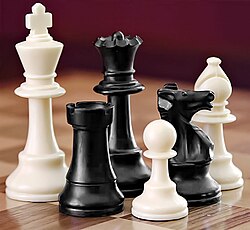
Back Skaak Afrikaans Schach ALS ሰንጠረዥ Amharic Escaques AN Blēobord ANG शतरंज ANP شطرنج Arabic ܛܠܦܣܢܐ ARC شطرنج ARY شطرنج ARZ
 | |
| Years active | c. 1475 to present[1] (predecessors c. 900 years earlier) |
|---|---|
| Genres | |
| Players | 2 |
| Chance | None |
| Skills | Strategy, tactics |
| Synonyms |
|
Chess is a board game for two players, called White and Black, each controlling an army of chess pieces, with the objective to checkmate the opponent's king. It is sometimes called international chess or Western chess to distinguish it from related games such as xiangqi (Chinese chess) and shogi (Japanese chess). The recorded history of chess goes back at least to the emergence of a similar game, chaturanga, in seventh-century India. The rules of chess as they are known today emerged in Europe at the end of the 15th century, with standardization and universal acceptance by the end of the 19th century. Today, chess is one of the world's most popular games, and is played by millions of people worldwide.
Chess is an abstract strategy game that involves no hidden information and no elements of chance. It is played on a chessboard with 64 squares arranged in an 8×8 grid. At the start, each player controls sixteen pieces: one king, one queen, two rooks, two bishops, two knights, and eight pawns. White moves first, followed by Black. The game is won by checkmating the opponent's king, i.e. threatening it with inescapable capture. There are also several ways a game can end in a draw.
Organized chess arose in the 19th century. Chess competition today is governed internationally by FIDE (Fédération Internationale des Échecs; the International Chess Federation). The first universally recognized World Chess Champion, Wilhelm Steinitz, claimed his title in 1886; Ding Liren is the current World Champion. A huge body of chess theory has developed since the game's inception. Aspects of art are found in chess composition, and chess in its turn influenced Western culture and the arts, and has connections with other fields such as mathematics, computer science, and psychology.
One of the goals of early computer scientists was to create a chess-playing machine. In 1997, Deep Blue became the first computer to beat the reigning World Champion in a match when it defeated Garry Kasparov. Today's chess engines are significantly stronger than the best human players and have deeply influenced the development of chess theory; however, chess is not a solved game.
- ^ A World of Chess, Jean-Louis Cazaux and Rick Knowlton, p. 244
© MMXXIII Rich X Search. We shall prevail. All rights reserved. Rich X Search